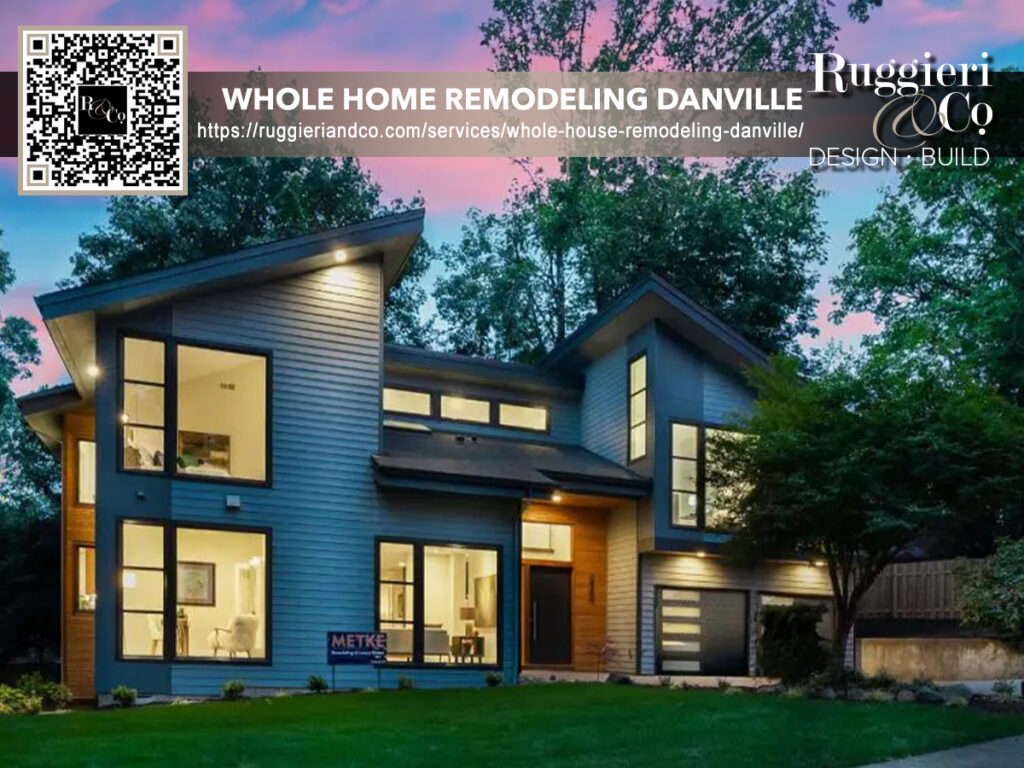Remodeling your home for energy efficiency goes beyond basic weatherization measures. By taking steps to improve the energy performance of your entire house, you can reduce energy consumption and create a more comfortable living environment. Whether you’re considering a complete home remodel or simply looking to make targeted energy-efficient upgrades, there are various ways to enhance the energy efficiency of your home through whole house remodeling.
An essential first step in improving energy efficiency is conducting a thorough home energy audit in Danville, CA. This audit provides a comprehensive assessment of your home’s energy performance and offers recommendations for improvements. You can choose to hire a professional energy auditor or utilize online tools to perform the audit yourself.
Some common energy-efficient remodeling measures include weatherization, such as insulating walls and attics, air sealing to eliminate drafts, repairing roofs, and replacing traditional incandescent bulbs with energy-efficient compact fluorescent bulbs. Additionally, more extensive upgrades may involve complete envelope air sealing and the replacement of outdated heating, cooling, and water heating systems.
Considering energy performance during a larger remodeling project can save you both time and money. By incorporating energy-efficient features into your remodel, you can reduce energy costs in the long run and enhance the overall value of your home.
Key Takeaways:
- Whole house remodeling can significantly improve energy efficiency.
- Start by conducting a home energy audit to identify areas for improvement.
- Weatherization measures such as insulation and air sealing can enhance energy efficiency.
- Consider upgrading to energy-efficient appliances and fixtures.
- Explore financial incentives available for energy-efficient home remodeling.
Tips for Increasing Energy Efficiency During Whole House Remodeling
When undertaking a whole house remodeling project to increase energy efficiency, there are several key tips to keep in mind. By following these guidelines, homeowners can maximize the benefits of their renovation and create a more energy-saving home:
- Start with a comprehensive energy audit: Before beginning any remodeling work, it’s essential to conduct a thorough energy audit. This will help identify areas of energy waste and guide the prioritization of energy-saving upgrades.
- Focus on insulation and air sealing: Proper insulation and air sealing are fundamental to improving energy efficiency. Consider upgrading insulation in the walls, attic, and basement, and seal any gaps or cracks where air may escape or enter the home.
- Upgrade to energy-efficient appliances and fixtures: Replace old, energy-guzzling appliances with energy-efficient models. Look for the ENERGY STAR label, which indicates superior energy performance. Additionally, consider installing low-flow fixtures and efficient plumbing systems to reduce water consumption.
- Invest in high-performance windows and doors: Windows and doors are significant sources of heat gain or loss. Opt for energy-efficient windows with low U-values and high solar heat gain coefficients. Choose insulated doors with weatherstripping to prevent air leakage.
- Consider renewable energy systems: Incorporating renewable energy sources, such as solar panels or geothermal heating and cooling systems, can further enhance the energy efficiency of a home. These systems can generate clean, sustainable energy and reduce reliance on traditional power sources.
By implementing these tips during the whole house remodeling process, homeowners can substantially increase energy efficiency, reduce utility bills, and create a more sustainable living space.
Table: Energy-Efficient Upgrades for Whole House Remodeling
| Upgrade | Description |
|---|---|
| Insulation | Improve insulation in walls, attic, and basement to minimize heat transfer and enhance energy efficiency. |
| Air Sealing | Seal gaps and cracks to prevent air leakage and maintain a more comfortable and energy-efficient home. |
| Energy-Efficient Appliances | Replace old appliances with ENERGY STAR certified models for increased energy savings. |
| Low-Flow Fixtures | Install low-flow faucets, showerheads, and toilets to conserve water without sacrificing performance. |
| High-Performance Windows | Upgrade to energy-efficient windows with low U-values and high solar heat gain coefficients. |
| Insulated Doors | Choose insulated doors with weatherstripping to minimize air leakage and optimize energy efficiency. |
| Renewable Energy Systems | Consider installing solar panels or geothermal heating and cooling systems to generate clean, renewable energy. |
Implementing these energy-efficient upgrades during whole house remodeling can have a significant impact on both the environmental sustainability and cost savings of a home. By making smart choices and investing in energy-saving solutions, homeowners can create a comfortable and eco-friendly living space for years to come.
Designing an Energy-Efficient Home or Remodeling Project

When it comes to creating an energy-efficient home or embarking on a remodeling project, there are several key considerations to keep in mind. By incorporating smart design choices and utilizing energy-efficient features, homeowners can significantly reduce their energy consumption and create a more sustainable living space. Read, learn, and enjoy this awesome article: How to Create a Luxury Spa Experience in Your Home Bathroom.
Energy-Efficient Design Options
One of the first things to consider when designing an energy-efficient home or remodeling project is the layout and orientation of the building. By optimizing the orientation to maximize natural lighting and heat gain during the winter while minimizing it during the summer, homeowners can reduce their reliance on artificial lighting and air conditioning. Additionally, incorporating energy-efficient windows and doors with proper insulation can help prevent heat loss or gain, further improving energy efficiency.
Energy-Efficient Landscaping
Another often overlooked aspect of energy-efficient design is landscaping. Strategic placement of trees and shrubs can provide shade in the summer, reducing the need for excess cooling, while also acting as windbreaks in the winter, minimizing heat loss. Furthermore, using native plants that require less water and maintenance can contribute to overall energy savings and environmental sustainability.
Windows and Doors for Energy Efficiency
Windows and doors play a crucial role in the energy efficiency of a home. Opting for high-performance windows that feature low-emissivity coatings and multiple panes can enhance insulation and reduce heat transfer. Additionally, choosing energy-efficient doors with proper sealing can help minimize drafts and prevent energy loss.
By incorporating these energy-efficient design options, homeowners can create a more sustainable and comfortable living space while reducing their environmental impact and energy bills.
Energy-Efficient Options for Different Types of Homes
When it comes to energy efficiency, every type of home has its unique considerations. Whether you live in an apartment, rental property, log home, or manufactured home, there are specific options available to help you improve energy efficiency and reduce your energy consumption.
For apartments and rentals, one of the most effective ways to enhance energy efficiency is by focusing on energy-saving practices. This includes using energy-efficient appliances, such as ENERGY STAR-rated refrigerators and dishwashers, and installing LED light bulbs throughout the space. Additionally, proper insulation and weatherstripping can help minimize heat loss and reduce energy waste.
In log homes, maintaining proper insulation is crucial. Log homes tend to have unique construction methods that can make it challenging to achieve optimal insulation levels. However, with the use of specialized insulation materials and techniques, log homes can become more energy-efficient. Additionally, investing in energy-efficient windows and doors can help minimize air leakage and improve overall energy performance.
Manufactured homes often have specific energy efficiency challenges due to their construction and design. However, several measures can be taken to improve energy efficiency in these homes. Upgrading to high-efficiency heating and cooling systems, adding insulation, and sealing air leaks are some of the key steps that can be taken to enhance energy performance. Additionally, installing energy-efficient windows and appliances can further contribute to energy savings in manufactured homes. Educate yourself on How to Choose the Right Type of Room Addition for Your Home.
Summary Table: Energy-Efficient Options for Different Types of Homes
| Home Type | Key Energy-Efficient Options |
|---|---|
| Apartments and Rentals | Use energy-efficient appliances, install LED light bulbs, improve insulation, and weatherstripping |
| Log Homes | Focus on insulation, invest in energy-efficient windows and doors |
| Manufactured Homes | Upgrade heating and cooling systems, add insulation, seal air leaks, install energy-efficient windows and appliances |
By considering these energy-efficient options tailored to different types of homes, homeowners and renters alike can make significant strides in reducing their energy consumption and lowering utility costs. It’s essential to prioritize energy efficiency and explore the available options to create a more sustainable living environment.
Conclusion
Whole house remodeling offers an excellent opportunity to improve energy efficiency in your home. By implementing energy-saving measures during the remodeling process, you can significantly reduce energy consumption and create a more comfortable living environment.
One of the key tips for increasing energy efficiency during remodeling is to prioritize weatherization measures. Insulation, air sealing, and roof repairs can prevent energy loss, while the replacement of incandescent bulbs with compact fluorescent bulbs can save on lighting energy. Additionally, upgrading to energy-efficient appliances and fixtures can further enhance your home’s energy performance.
For those looking to take their energy efficiency efforts to the next level, incorporating renewable energy systems is a great option. Solar panels, geothermal heating, and energy-efficient windows and doors can all contribute to a more sustainable and energy-saving home.
It’s important to keep in mind that different types of homes have specific energy-efficient options to consider. Whether you live in an apartment, log home, or manufactured home, there are tailored solutions available for your unique circumstances. Working with professionals experienced in energy-efficient remodeling can ensure that you make the most effective choices for your home. By taking advantage of available financial incentives, such as tax credits and loans, you can offset the costs of energy-efficient upgrades and reap the long-term benefits of reduced energy bills.
Ruggieri & Co Home Remodeling Danville is a premier home remodeling contractor in Danville, CA, and the surrounding areas. We specialize in creating dream homes with the highest standards and a personal touch. With over 20 years of experience, we guarantee superior craftsmanship and attention to detail. We offer free quotes for our services and strive to provide our customers with the best service and value. From interior and exterior renovations to custom work, we are your go-to source for all home remodeling needs. Visit us today at 290 Rose St # A, Danville, CA 94526, and let us help you make your dream home a reality.
FAQ
How can whole house remodeling improve energy efficiency?
Whole house remodeling can improve energy efficiency by incorporating weatherization measures, upgrading to energy-efficient appliances and fixtures, and incorporating renewable energy systems.
What should be considered when designing an energy-efficient home or remodeling project?
When designing an energy-efficient home or remodeling project, it is important to consider options such as energy-efficient windows and doors, proper insulation, and energy-efficient landscaping.
What are some energy-efficient options for different types of homes?
Energy-efficient options for different types of homes include energy-efficient appliances and fixtures, weatherization measures, and renewable energy systems. Specific considerations should be made for apartments and rentals, log homes, and manufactured homes.
How can whole house remodeling save on energy costs?
Whole house remodeling can save on energy costs by reducing energy use through improved insulation, air sealing, and the use of energy-efficient appliances and fixtures. It can also incorporate renewable energy systems to offset energy consumption.








